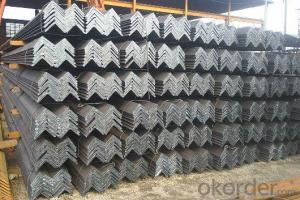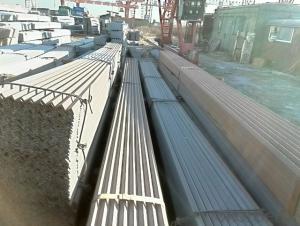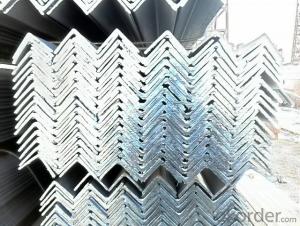Hot Rolled Equal Angle Steel with Best Price
- Loading Port:
- Tianjin
- Payment Terms:
- TT OR LC
- Min Order Qty:
- 25 m.t.
- Supply Capability:
- 20000 m.t./month
OKorder Service Pledge
OKorder Financial Service
You Might Also Like
Product Description:
OKorder is offering high quality Hot Rolled Equal Angle Steel at great prices with worldwide shipping. Our supplier is a world-class manufacturer of steel, with our products utilized the world over. OKorder annually supplies products to European, North American and Asian markets. We provide quotations within 24 hours of receiving an inquiry and guarantee competitive prices.
Product Applications:
Hot Rolled Equal Angle Steels are ideal for structural applications and are widely used in the construction of buildings and bridges, and the manufacturing, petrochemical, and transportation industries.
Product Advantages:
OKorder's Hot Rolled Equal Angle Steels are durable, strong, and resist corrosion.
Main Product Features:
· Premium quality
· Prompt delivery & seaworthy packing (30 days after receiving deposit)
· Corrosion resistance
· Can be recycled and reused
· Mill test certification
· Professional Service
· Competitive pricing
Product Specifications:
Manufacture: Hot rolled
Grade: Q195 – 235
Certificates: ISO, SGS, BV, CIQ
Length: 6m – 12m, as per customer request
Packaging: Export packing, nude packing, bundled
Sizes: 25mm-250mm | ||
a*t | ||
25*2.5-4.0 | 70*6.0-9.0 | 130*9.0-15 |
30*2.5-6.6 | 75*6.0-9.0 | 140*10-14 |
36*3.0-5.0 | 80*5.0-10 | 150*10-20 |
38*2.3-6.0 | 90*7.0-10 | 160*10-16 |
40*3.0-5.0 | 100*6.0-12 | 175*12-15 |
45*4.0-6.0 | 110*8.0-10 | 180*12-18 |
50*4.0-6.0 | 120*6.0-15 | 200*14-25 |
60*4.0-8.0 | 125*8.0-14 | 250*25 |
FAQ:
Q1: Why buy Materials & Equipment from OKorder.com?
A1: All products offered byOKorder.com are carefully selected from China's most reliable manufacturing enterprises. Through its ISO certifications, OKorder.com adheres to the highest standards and a commitment to supply chain safety and customer satisfaction.
Q2: What makes stainless steel stainless?
A2: Stainless steel must contain at least 10.5 % chromium. It is this element that reacts with the oxygen in the air to form a complex chrome-oxide surface layer that is invisible but strong enough to prevent further oxygen from "staining" (rusting) the surface. Higher levels of chromium and the addition of other alloying elements such as nickel and molybdenum enhance this surface layer and improve the corrosion resistance of the stainless material.
Q3: Can stainless steel rust?
A3: Stainless does not "rust" as you think of regular steel rusting with a red oxide on the surface that flakes off. If you see red rust it is probably due to some iron particles that have contaminated the surface of the stainless steel and it is these iron particles that are rusting. Look at the source of the rusting and see if you can remove it from the surface.
Images:
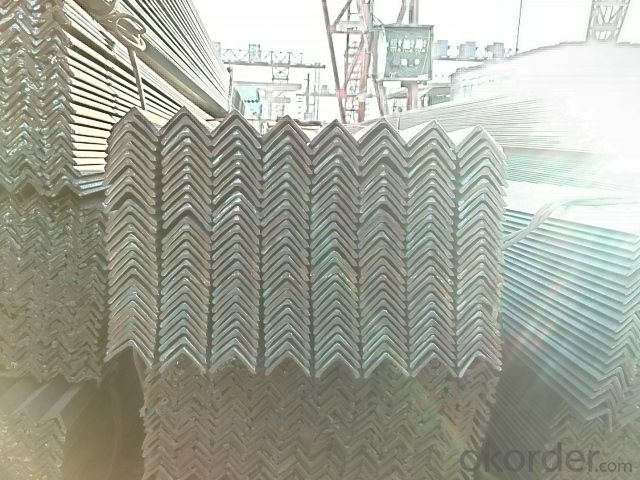
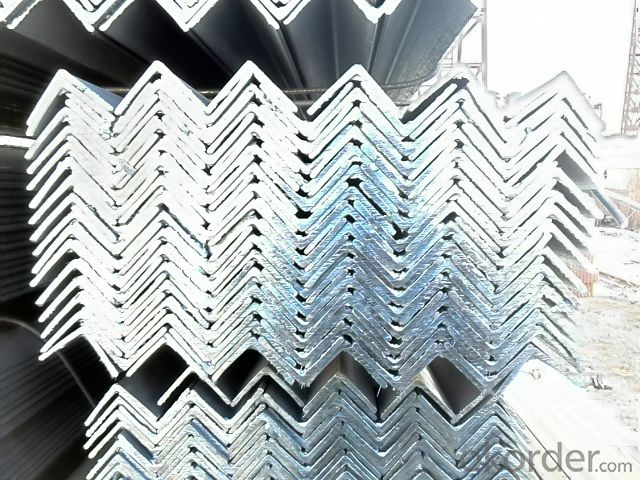

- Q:What are the different grades of steel used in manufacturing steel angles?
- The different grades of steel used in manufacturing steel angles vary depending on the specific requirements and intended applications. Some common grades include A36, A572, and A588. A36 is a low carbon steel that is often used in general structural applications. A572 is a high-strength, low-alloy steel that is commonly used in construction and engineering projects. A588 is a weathering steel that is known for its corrosion resistance and is often used in outdoor structures.
- Q:What are the different testing methods for steel angles?
- There are several testing methods for steel angles, including visual inspection, dimensional measurement, hardness testing, chemical analysis, and mechanical testing. Visual inspection involves examining the angles for any visual defects or irregularities. Dimensional measurement ensures that the angles meet the specified size and shape requirements. Hardness testing determines the hardness of the steel, which is an important factor in its strength and durability. Chemical analysis is performed to check the composition and purity of the steel, ensuring that it meets the required standards. Mechanical testing involves subjecting the steel angles to various loads and stresses to evaluate their mechanical properties such as strength and ductility.
- Q:Can steel angles be customized to specific dimensions?
- Yes, steel angles can be customized to specific dimensions. They can be cut, bent, and shaped according to the required measurements and specifications.
- Q:Are steel angles suitable for historical restoration projects?
- Yes, steel angles can be suitable for historical restoration projects. Steel angles are versatile and durable, making them an excellent choice for structural support and reinforcement in historic buildings. They can be used to restore or replicate original architectural features, such as window frames, ornamental railings, and decorative elements. Additionally, steel angles can be fabricated to match the original design and provide a seamless integration with the existing structure. However, it is important to consider the specific requirements and regulations of the historical restoration project, as some preservation authorities may have restrictions on the use of modern materials. Consulting with experts in historical restoration and obtaining necessary approvals will ensure that steel angles are used appropriately and effectively in preserving the historical integrity of the building.
- Q:Can steel angles be used in lighting or electrical fixtures?
- Yes, steel angles can be used in lighting or electrical fixtures. Steel angles are versatile and can be easily fabricated into various shapes and sizes, making them suitable for a wide range of applications. In lighting fixtures, steel angles can be used as brackets or supports to hold the lighting components securely in place. They provide strength and stability to the fixture, ensuring that it can withstand the weight of the lighting elements. Similarly, in electrical fixtures, steel angles can be used as frames or mounting brackets to hold electrical components such as switches, outlets, or junction boxes. The durability and load-bearing capacity of steel angles make them an ideal choice for these applications, as they can handle the weight and stress associated with lighting or electrical fixtures. Additionally, steel angles can be easily painted or coated to match the aesthetic requirements of the fixture, making them a versatile and practical choice for lighting or electrical applications.
- Q:What are the common thicknesses of steel angles?
- The specific application and industry requirements determine the varying common thicknesses of steel angles. Examples of frequently utilized thicknesses for steel angles are 1/8 inch, 3/16 inch, 1/4 inch, 3/8 inch, and 1/2 inch. These thicknesses find common usage in construction, manufacturing, and structural applications. It is worth noting that thicker steel angles offer enhanced strength and durability, whereas thinner angles are suitable for lighter applications. Ultimately, the decision regarding thickness depends on the specific load-bearing requirements and considerations of the structural design.
- Q:Can steel angles be used for bracing or reinforcement?
- Yes, steel angles can be used for bracing or reinforcement purposes. Steel angles, also known as angle irons, are L-shaped structural steel members that are commonly used in construction and engineering applications. Their shape and structural properties make them ideal for providing bracing or reinforcement in various structures. Steel angles can be used to reinforce beams, columns, or trusses by providing additional strength and stability. They can also be used as bracing elements to resist lateral loads, such as wind or seismic forces, and prevent structural failure. Additionally, steel angles can be welded, bolted, or riveted to other structural members, making them versatile and easy to install. The choice of steel angle size and thickness will depend on the specific application and load requirements. It is important to consult with a structural engineer or follow applicable building codes and regulations to ensure the proper use and installation of steel angles for bracing or reinforcement purposes.
- Q:How are steel angles protected against fire damage?
- Fire-resistant coatings and fireproofing materials are commonly used to protect steel angles from fire damage. These measures aim to prevent or delay the steel from reaching its critical temperature, which can compromise its structural integrity. One popular method of safeguarding steel angles involves applying intumescent coatings. These coatings expand when exposed to high temperatures, creating a protective char layer that insulates the steel and slows down heat transfer. This process effectively hinders the steel from rapidly increasing in temperature, thus enhancing its fire resistance capabilities. Another approach is to utilize fireproofing materials, such as concrete or gypsum-based sprays or boards. These materials act as a barrier between the steel angles and the fire, providing insulation and preventing the heat from reaching the steel. Fireproofing materials are commonly employed in buildings with higher fire resistance requirements, such as tall buildings or industrial facilities. In certain cases, steel angles can be enclosed within fire-rated enclosures for added protection. This entails enclosing the steel angles within fire-rated walls, floors, or ceilings made of materials with exceptional fire resistance properties. These enclosures effectively isolate the steel angles from potential fire sources, adding an extra layer of defense. It is important to acknowledge that the specific fire protection measures for steel angles can vary based on building codes, fire safety regulations, and the intended use of the structure. Consulting with fire protection engineers and adhering to the appropriate guidelines will ensure that the steel angles are adequately shielded against fire damage.
- Q:How many kilograms per square meter is angle steel 63*63*6?
- Angle gaugeCalculation method of angle weight:Weight per meter =0.00785* (edge width + edge width - side thickness) * edge thicknessEquilateral angle steel, kg/m equal angle steel, kg/m equal angle steel, kg/m25*3 1.124, 70*8 8.373, 110*12 19.78225*4 1.459, 75*5 5.818, 110*14 22.80930*3 1.373, 75*6 6.905, 120*10 18.20030*4 1.786, 75*7 7.976, 120*12 21.60040*3 1.852, 75*8 9.030, 125*8 15.504
- Q:Can steel angles be used in shelving systems?
- Yes, steel angles can be used in shelving systems. Steel angles provide excellent structural support and stability, making them a popular choice for shelving units. They can be easily attached to walls or used as vertical supports, allowing for the customization of shelving layouts. Additionally, steel angles are durable and capable of holding heavy loads, making them suitable for various storage needs.
1. Manufacturer Overview |
|
|---|---|
| Location | |
| Year Established | |
| Annual Output Value | |
| Main Markets | |
| Company Certifications | |
2. Manufacturer Certificates |
|
|---|---|
| a) Certification Name | |
| Range | |
| Reference | |
| Validity Period | |
3. Manufacturer Capability |
|
|---|---|
| a)Trade Capacity | |
| Nearest Port | |
| Export Percentage | |
| No.of Employees in Trade Department | |
| Language Spoken: | |
| b)Factory Information | |
| Factory Size: | |
| No. of Production Lines | |
| Contract Manufacturing | |
| Product Price Range | |
Send your message to us
Hot Rolled Equal Angle Steel with Best Price
- Loading Port:
- Tianjin
- Payment Terms:
- TT OR LC
- Min Order Qty:
- 25 m.t.
- Supply Capability:
- 20000 m.t./month
OKorder Service Pledge
OKorder Financial Service
Similar products
New products
Hot products
Hot Searches
Related keywords
